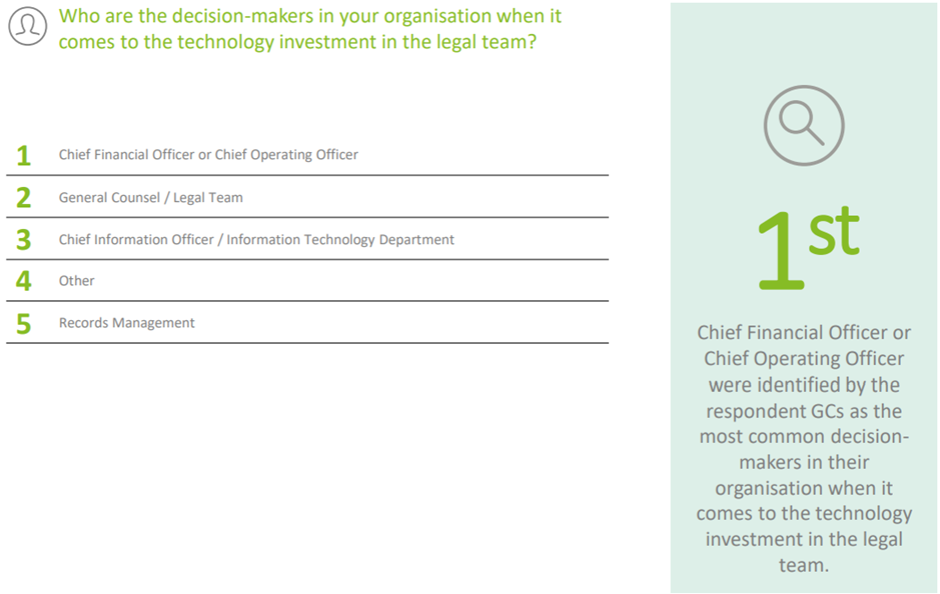
Legal teams often rely on support from Finance, IT, or Procurement to access new technology and systems.
This is confirmed in the Deloitte In-house Insights Report “Trusted navigators in complex and challenging environments”, prepared in response to the September 2022 survey of New Zealand's in-house legal community, which identified the CFO/COO as the most common decision maker, followed by the CIO/IT Department.

While other parties may be the decision makers (or at least have a significant say), we come across many people in legal teams with an almost fatalistic view of their circumstances. For example, believing that:
- If there is currently no budget for new technology, funding couldn't be found with a good business case demonstrating a solid return on investment;
- If IT and procurement support is needed, it wouldn't be forthcoming, even if you could demonstrate this project aligns with their own priorities or the priorities of the organisation;
- IT projects are necessarily expensive and risky, and it isn't possible to test alternatives in a low-cost, low-risk way; and
- IT and Procurement set the rules and must run the whole process.
Letting IT or procurement teams take too much control over the legal and broader business process is a crucial mistake for legal teams. They should be there to help you meet your objectives, not to set or control them.
Sometimes, a project never gets going because there's no existing budget, and obtaining one is not seen as possible, even if the project squarely aligns with the organisation's objectives.
In other cases, the project is taken in another direction, where it meets the needs of IT or another department rather than legal or the business.
An example scenario
The following example contains mistakes that we have seen several times and which are easily avoidable.
- The process of selecting a new document automation solution for a business-critical legal document creation process is almost entirely led by IT and Procurement, with little apparent involvement by senior business owners or the legal team.
- Budgets are set before the size of the problem, and the value that can be obtained, has been truly understood.
- The RFP document has hundreds of rows in a spreadsheet asking about every technical and security feature imagineable. However, there is little in the documents to indicate what processes need automating and why.
- When asked, those leading the process don't know the detailed use cases. Procurement and IT will choose "the best", or the "best value" (lowest cost) technology, and then (someone else will) work out which processes to automate. In reality, some of the documents and processes that need to be automated are actually very complicated.
- The people who most need the solution—the business owners and the legal team—aren't even in the room, and the decision is made for them by people with no ongoing stake in the game. Several different procurement leads—mostly contractors—will start and leave the project within months.
- Once the decision is made, there will be extreme reluctance to admit any form of mistake, and rather than revisit the original decision, most efforts will go into making the selected optional workable in some way, even if it won't meet the original objectives.
- Frustrated business owners and members of the legal team will say that if they had known then what they know now, they would have made different choices, but they needed to be more involved in the process earlier, and it's now too late.
Good communication and avoiding silos is key
From our observations, silos are a key cause of these types of problems. If the various stakeholders don't take the time to develop a strong relationship with a shared understanding of each other's key issues and priorities and what outcomes are required, problems will invariably arise.
That type of strong, ongoing relationship can be invaluable and should be built well in advance of when needed.
We often see legal and IT teams talking past each other - without an understanding of what the other is really saying or needs. With our combined skills as lawyers and automators, we often find we can help to bridge the gap, and in particular can help legal teams understand and communicate why they need something more than what is being offered, and what the benefits will be. If that type of help could be useful, get in touch for a chat.
%20(1).jpg?width=290&name=Gene%20-%20December%202020%20v2%20(1)%20(1).jpg)




